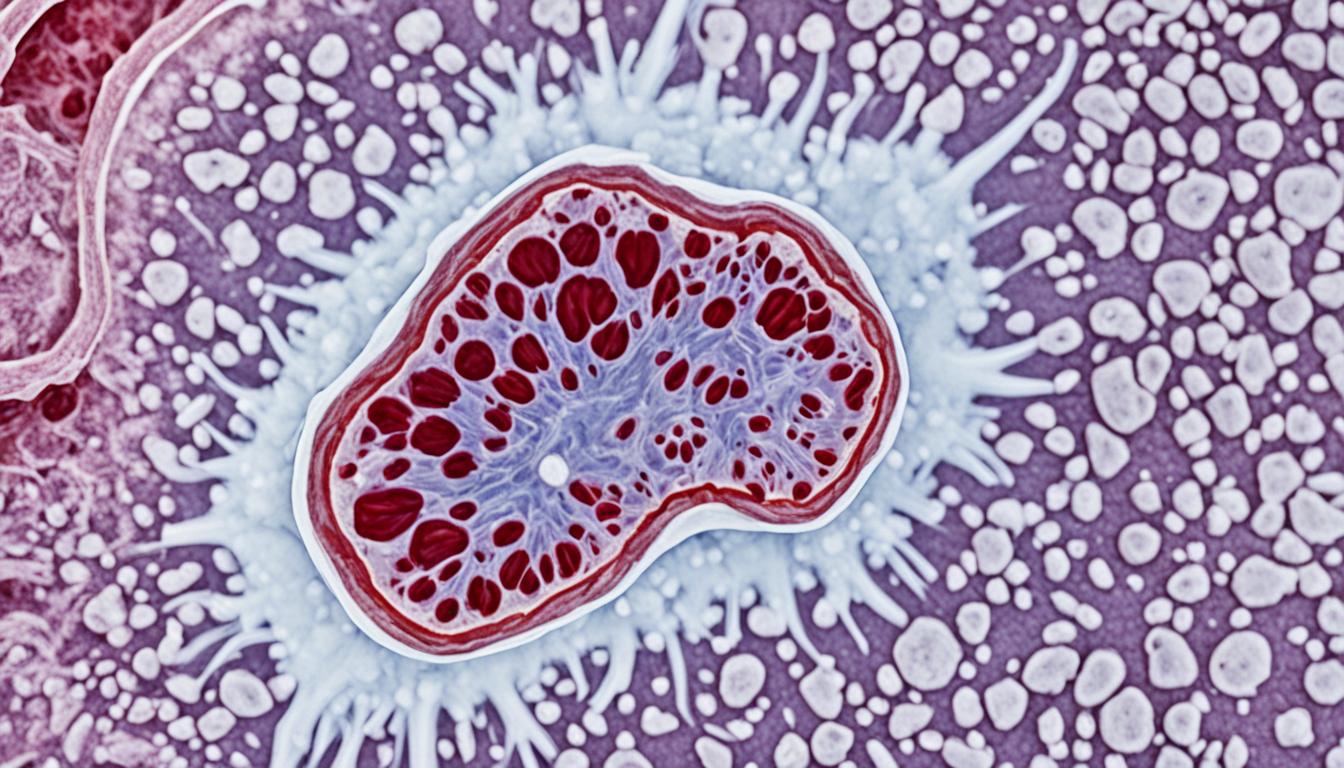Benign adrenal tumors are not common. They are noncancerous growths in the adrenal glands. Found in the adrenal gland’s cortex, they’re known as adrenocortical adenomas or cortical adenomas. Many don’t show symptoms or need urgent treatment. Yet, some can release high hormone levels. This can lead to health issues, particularly in the cardiovascular system.
The symptoms depend on the hormone type the tumor releases. Tumors making too much aldosterone cause Conn syndrome. This leads to high blood pressure, low potassium, weakness, and cramps. If a tumor makes too much cortisol, it results in Cushing’s syndrome. Symptoms include weight gain, a rounded face, and mood changes. Excess sex hormones can also create unique challenges based on the patient’s gender.
To diagnose benign adrenal tumors, doctors use urine and blood tests for hormone levels. They also use imaging methods like CT scans, MRI, and PET scans to see the tumor. Sometimes, a biopsy is needed to make sure of the diagnosis.
Treatment depends on if the tumor is active. Tumors that don’t release hormones might not need treatment right away. But, they must be watched over time. Active tumors are often removed with laparoscopic surgery, called adrenalectomy. There’s also medicine to control hormone levels if surgery isn’t an option.
Key Takeaways:
- Benign adrenal tumors are usually noncancerous but can cause complications when hormone production is excessive.
- Symptoms vary depending on the hormones released by the tumor, such as high blood pressure, weight gain, and mood swings.
- Diagnosis involves hormone level tests and imaging techniques like CT scans, MRI, and PET.
- Treatment options include surgery and medication, depending on tumor activity.
- Stem cell therapy shows promise as a potential treatment for benign adrenal tumors.
Symptoms of Benign Adrenal Tumors
Most benign adrenal tumors are found by chance during health checks or other tests. They usually don’t cause symptoms. But if the tumor makes too much of certain hormones, symptoms can appear.
Having too much aldosterone can cause Conn syndrome. This leads to high blood pressure, low potassium, weakness, and cramps. Too much cortisol may cause Cushing’s syndrome, showing up as weight gain, a round face, and mood changes. And if the tumor makes too much sex hormone, it can lead to different issues in men and women.
Rarely, adrenal medulla tumors can make too much adrenaline or norepinephrine. This can result in high blood pressure, a red face, sweating, headaches, and a fast heartbeat.
Aldosterone and Conn Syndrome
When a benign tumor raises aldosterone, it can lead to Conn syndrome. This situation brings on high blood pressure, low potassium, weakness, and cramps. Symptoms can be light or serious, based on how much aldosterone is made.
Cortisol and Cushing’s Syndrome
A benign tumor that makes extra cortisol can cause Cushing’s syndrome. This condition’s signs include gaining weight around the stomach and face, thin skin, bruising easily, weak muscles, and mood swings.
Sex Hormones and Gender-Specific Symptoms
Benign tumors that pump out extra sex hormones can cause different symptoms in men and women. Men might get breast enlargement, lose interest in sex, and have less muscle. Women could get more body hair, irregular periods, and show male traits.
Adrenaline and Norepinephrine Overproduction
Tumors in the adrenal medulla that make too much adrenaline or norepinephrine can lead to pheochromocytoma. This causes high blood pressure, a red face, sweating, headaches, a fast heartbeat, and palpitation.
Symptoms can vary by person and tumor type. If you have concerning symptoms or worries about adrenal health, see a doctor for a check-up and diagnosis.
Diagnosis of Benign Adrenal Tumors
Doctors use a detailed approach to diagnose benign adrenal tumors. They start with physical exams and look into symptoms and medical history.
Imaging techniques are key for seeing the tumors and finding out their details. The main methods are:
- Computed Tomography (CT) Scans: CT scans use X-rays and computers for high-quality images of the adrenal glands. This helps spot any issues or tumors.
- Magnetic Resonance Imaging (MRI): MRIs employ magnetic fields and radio waves for clear pictures of the adrenal glands. They offer extra details on the tumors’ size, appearance, and position.
- Positron Emission Tomography (PET): PET scans involve a bit of radioactive material to get functional images of the adrenal glands. This is useful in checking how active the tumors are.
Doctors also check hormone level tests to see if the tumor is making hormones. They use blood or urine tests to measure these levels.
Sometimes, a biopsy is needed to make sure of the diagnosis. In a biopsy, doctors take a tiny piece of the tumor to look at under a microscope.
Genetic testing isn’t usually done for these tumors. But it might be suggested for people with a family history of such tumors.

| Diagnostic Methods | Advantages | Disadvantages |
|---|---|---|
| Imaging Techniques (CT scans, MRI, PET) | – Provides detailed images of the adrenal glands – Allows visualization of tumors |
– May require contrast agents for enhanced visualization – Exposure to radiation in CT scans |
| Hormone Level Tests | – Assesses tumor activity – Determines hormone production levels |
– Limited specificity as hormone levels can fluctuate – Requires interpretation by an experienced professional |
| Biopsy | – Confirms the diagnosis – Provides information about tumor characteristics |
– Invasive procedure with potential risks – Small risk of complications |
Treatment of Benign Adrenal Tumors
The treatment for benign adrenal tumors depends on several factors. This includes whether the tumor is active or not. If the tumor doesn’t release hormones, immediate treatment might not be needed. Still, it’s important to keep an eye on the tumor to avoid any problems.
When tumors are active and make too much hormones, doctors usually suggest removing them. They often use laparoscopic surgery, which is a less invasive method. This surgery has benefits like smaller cuts, less pain, and quicker recovery times. Laparoscopic adrenalectomy is the preferred method for removing these tumors. It allows doctors to take out the tumor carefully without harming healthy tissue.
If surgery isn’t an option or isn’t wanted, medicine can help. Medicine can either stop hormone production or lower hormone levels. This treatment helps control symptoms and prevent other issues. The type of medicine used depends on the hormones the tumor makes.
Vinmec International Hospital is skilled at laparoscopic surgery for treating benign adrenal tumors. The hospital is equipped with modern facilities and a professional medical team. This ensures patients are safe and receive effective treatment. The surgeons at Vinmec International Hospital are experienced and have a history of successful surgeries. They ensure patients get great care and recover smoothly.
Vinmec International Hospital focuses on giving patients the best care for benign adrenal tumors. Their goal is for patients to have the best results and better well-being.
References:
- “Laparoscopic Adrenalectomy.” MedLine Plus, U.S. National Library of Medicine, 2019.
- “Adrenalectomy.” Mayo Clinic, Mayo Foundation for Medical Education and Research, 2021.
- “Benign Adrenal Tumors.” Cedars-Sinai, 2021.
- “Treatment Options for Adrenal Tumors.” Memorial Sloan Kettering Cancer Center, 2021.
Causes of Adrenal Gland Tumors
The exact cause of adrenal gland tumors is not known. Studies show that some genetic conditions can make people more likely to get these tumors. Adenomatous polycystic disease and multiple endocrine neoplasia type 1 are two important conditions connected with these tumors.
Adenomatous polycystic disease: People with this condition have many cysts in organs like the kidneys and liver. They are more prone to getting adrenal gland tumors. Keeping an eye on and managing the disease can help lower the chances of getting these tumors.
Multiple endocrine neoplasia type 1: This condition increases the possibility of getting tumors in the adrenal glands and other endocrine glands. It is due to gene mutations that lead to multiple benign tumors. Getting checked regularly and spotting tumors early is key to control this risk.
Even though these genetic conditions can make people more likely to get adrenal gland tumors, not everyone with them will get tumors. Living a healthy life with exercise, good food, and stress control can help lower the risk.
Genetic Conditions Associated with Adrenal Gland Tumors
| Genetic Condition | Risk of Adrenal Gland Tumors |
|---|---|
| Adenomatous polycystic disease | Higher risk |
| Multiple endocrine neoplasia type 1 | Elevated risk |
Understanding how genetic conditions affect the risk of adrenal gland tumors is vital. Taking steps to manage these conditions can lower this risk and improve health. Seeing a doctor regularly for check-ups and early tumor detection is very important.
Conclusion
Benign adrenal tumors are usually not cancerous. But they can cause problems if they make too many hormones. To deal with these tumors, doctors look at symptoms, hormone levels, and use imaging.
Laparoscopic surgery is common for treating these tumors. If surgery isn’t the best choice, medication may be used instead. Also, stem cell therapy might be a future way to treat these tumors.
Knowing the causes, signs, and how to treat these tumors helps people make smart choices. This lets them get the right care for this rare condition.

